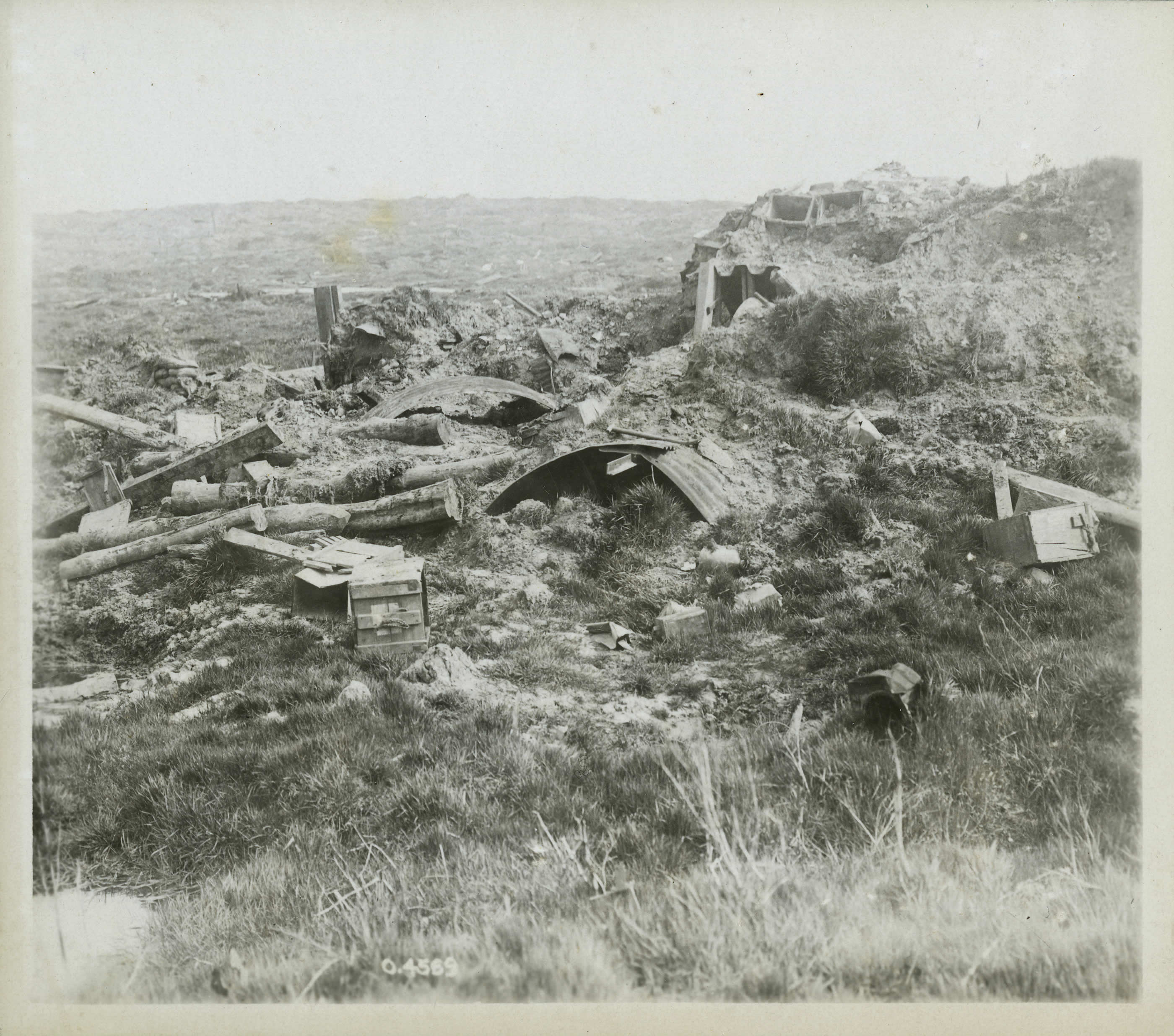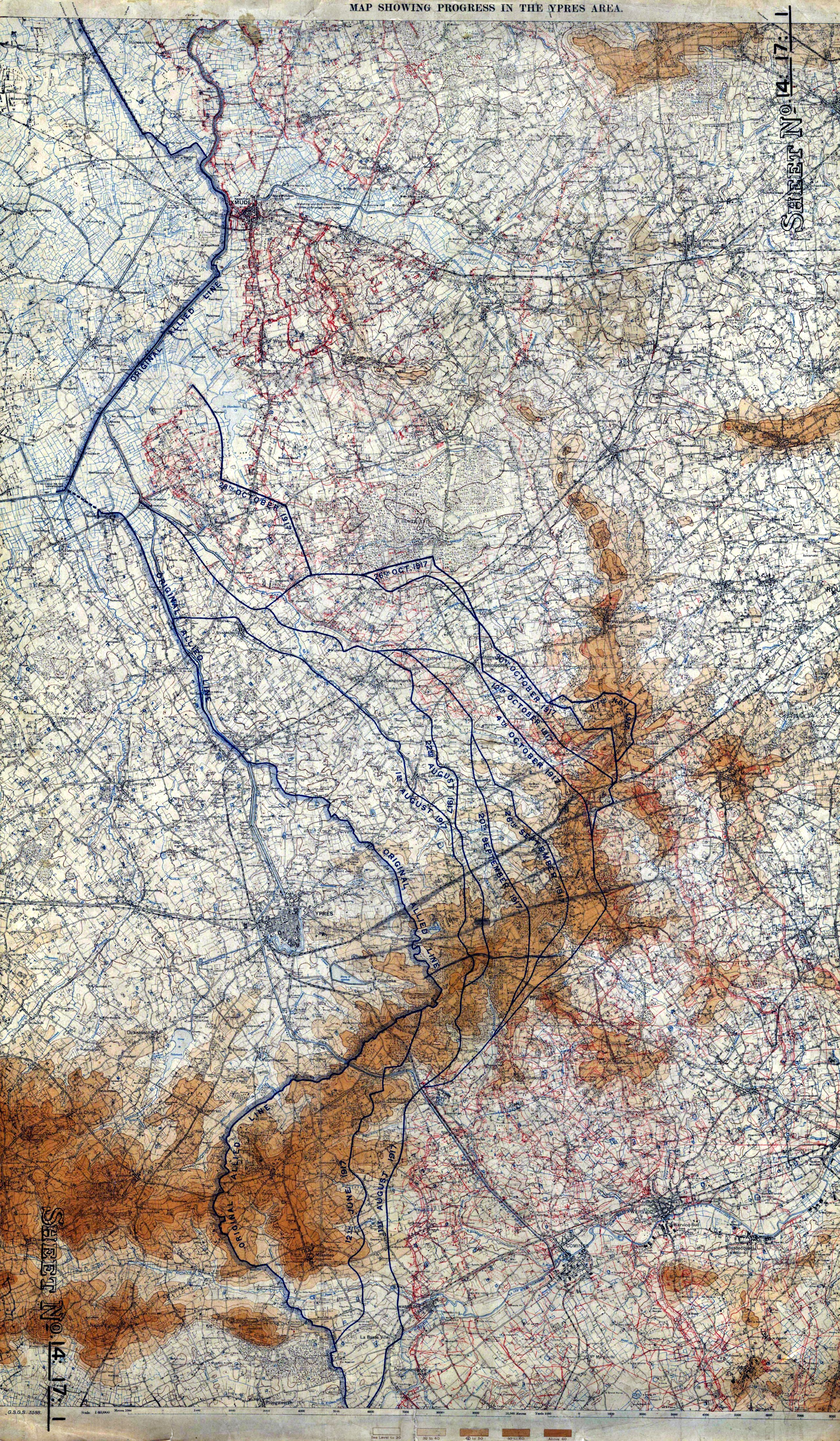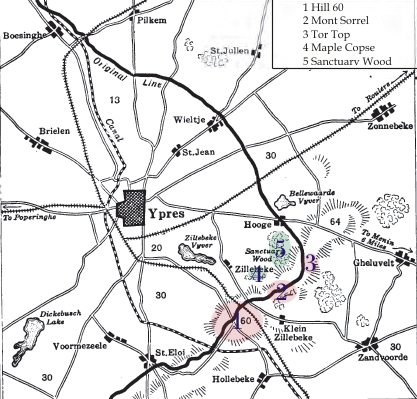|
Battle Of Mount Sorrel
The Battle of Mont Sorrel (Battle of Mount Sorrel) was a local operation in World War I by three divisions of the German 4th Army and three divisions of the British Second Army in the Ypres Salient, near Ypres in Belgium, from 2 to 13 June 1916. To divert British resources from the build-up being observed on the Somme, the XIII (Royal Württemberg) Corps and the 117th Infantry Division attacked an arc of high ground defended by the Canadian Corps in Flanders. The German forces captured the heights at Mount Sorrel and Tor Top, before entrenching on the far slope of the ridge. Following a number of attacks and counterattacks, two divisions of the Canadian Corps, supported by the 20th Light Division and Second Army siege and howitzer battery groups, recaptured the majority of their former positions. Background Mount Sorrel Located in the Ypres Salient, east of Ypres, Belgium and from Hill 60, the Battle of Mount Sorrel took place along a ridge between Hooge and Zwartele ... [...More Info...] [...Related Items...] OR: [Wikipedia] [Google] [Baidu] |
Ypres Salient
The Ypres Salient, around Ypres, in Belgium, was the scene of several battles and a major part of the Western Front during World War I. Location Ypres lies at the junction of the Ypres–Comines Canal and the Ieperlee. The city is overlooked by Kemmel Hill in the south-west and from the east by low hills running south-west to north-east with Wytschaete ( Wijtschate), Hill 60 to the east of Verbrandenmolen, Hooge, Polygon Wood and Passchendaele ( Passendale). The high point of the ridge is at Wytschaete, from Ypres, while at Hollebeke the ridge is distant and recedes to at Polygon Wood. Wytschaete is about above the plain; on the Ypres–Menin road at Hooge, the elevation is about and at Passchendaele. The rises are slight, apart from the vicinity of Zonnebeke, which has a From Hooge and to the east, the slope is near Hollebeke, it is heights are subtle but have the character of a saucer lip around Ypres. The main ridge has spurs sloping east and one is particularly ... [...More Info...] [...Related Items...] OR: [Wikipedia] [Google] [Baidu] |
Oberste Heeresleitung
The ''Oberste Heeresleitung'' (, "Supreme Army Command", OHL) was the highest echelon of command of the army (''Heer'') of the German Empire. In the latter part of World War I, the Third OHL assumed dictatorial powers and became the ''de facto'' political authority in the Empire. Formation and operation After the formation of the German Empire in 1871, the Prussian Army, Royal Saxon Army, Army of Württemberg and the Bavarian Army were autonomous in peacetime, each kingdom maintaining a separate war ministry and general staff to administer their forces. On the outbreak of war, the Constitution of the German Empire made the German Emperor commander-in-chief of the combined armies (''Oberster Kriegsherr'', "supreme warlord"). The Emperor's role as commander-in-chief was largely ceremonial and authority lay with the Chief of the German General Staff, who issued orders in the Emperor's name. The pre-war Chief of the General Staff was Colonel General Helmuth von Moltke and the ' ... [...More Info...] [...Related Items...] OR: [Wikipedia] [Google] [Baidu] |
Hooge In World War I
In World War I, the area around Hooge on Bellewaerde Ridge, about east of Ypres in Flanders in Belgium, was one of the easternmost sectors of the Ypres Salient and was the site of much fighting between German and Allied forces. Within a radius of Hooge are the sites of Château Wood, Sanctuary Wood, Railway Wood and Menin Road. There are four Commonwealth War Graves Commission (CWGC) war cemeteries in this area and several museums and memorials. Hill 62 and Mount Sorrel (Also Mont Sorrel) are further south, while the sites known to British and Commonwealth soldiers as Stirling Castle and Clapham Junction are further east. Background Hooge For much of the war, Hooge was one of the easternmost sectors of the Ypres Salient, being almost constantly exposed to enemy attacks from three sides. After the First Battle of Ypres in 1914, the front line of the salient ran through the Hooge area and there was almost constant fighting in the region over the next three years, durin ... [...More Info...] [...Related Items...] OR: [Wikipedia] [Google] [Baidu] |
Battle Of Jutland
The Battle of Jutland () was a naval battle between Britain's Royal Navy Grand Fleet, under Admiral John Jellicoe, 1st Earl Jellicoe, Sir John Jellicoe, and the Imperial German Navy's High Seas Fleet, under Vice-Admiral Reinhard Scheer, during the First World War. The battle unfolded in extensive manoeuvring and three main engagements from 31 May to 1 June 1916, off the North Sea coast of Denmark's Jutland Peninsula. It was the largest naval battle and only full-scale clash of battleships of the war, and the outcome ensured that the Royal Navy denied the German surface fleet access to the North Sea and the Atlantic for the remainder of the war. Germany avoided all fleet-to-fleet contact thereafter. Jutland was also the last major naval battle, in any war, fought primarily by battleships. Germany's High Seas Fleet intended to lure out, trap, and destroy a portion of the British Grand Fleet. The German naval force was insufficient to openly engage the British fleet. This was par ... [...More Info...] [...Related Items...] OR: [Wikipedia] [Google] [Baidu] |
Marinekorps Flandern
The Naval Corps () was a corps-sized formation within the Imperial Navy of the German Empire during World War I. It was formed in November 1914 and was still in existence at the end of the war. Chronicle The Naval Corps was formed on 20 November 1914 to command the land-based forces of the Imperial German Navy operating in Flanders. It was continuously based on the extreme right wing of the German line on the Western Front, up against the North Sea. It commanded the 1st Naval Division and 2nd Naval Division also including 3rd Naval Division throughout; one division held the land front, the other the sea front. It was still in existence at the end of the war in the 4th Army, ''Heeresgruppe Kronprinz Rupprecht'' on the Western Front, still holding the extreme right of the line. It had the following composition: * 1st Naval Division * 2nd Naval Division * two thirds 38th ''Landwehr'' Division * one third 3rd Division * 85th ''Landwehr'' Division Order of battle Mari ... [...More Info...] [...Related Items...] OR: [Wikipedia] [Google] [Baidu] |
XXVI Reserve Corps (German Empire)
The XXVI Reserve Corps () was a corps-level command of the German army during World War I World War I or the First World War (28 July 1914 – 11 November 1918), also known as the Great War, was a World war, global conflict between two coalitions: the Allies of World War I, Allies (or Entente) and the Central Powers. Fighting to .... Formation XXVI Reserve Corps was formed in October 1914. It was part of the first wave of new Corps formed at the outset of World War I consisting of XXII - XXVII Reserve Corps of 43rd - 54th Reserve Divisions (plus 6th Bavarian Reserve Division). The personnel was predominantly made up of (wartime volunteers) who did not wait to be called up. It was still in existence at the end of the war in the 18th Army, on the Western Front. Structure on formation On formation in October 1914, XXVI Reserve Corps consisted of two divisions. but was weaker than an Active Corps *Reserve Infantry Regiments consisted of three battalions but only ... [...More Info...] [...Related Items...] OR: [Wikipedia] [Google] [Baidu] |
XXIII Reserve Corps (German Empire)
The XXIII Reserve Corps () was a corps level command of the German Empire, German German Army (German Empire), Army in World War I. Formation XXIII Reserve Corps was formed in October 1914. It was part of the first wave of new Corps formed at the outset of World War I consisting of XXII - XXVII Reserve Corps of 43rd - 54th Reserve Divisions (plus 6th Bavarian Reserve Division). The personnel was predominantly made up of (wartime volunteers) who did not wait to be called up. It was dissolved on 12 August 1918. Structure on formation On formation in October 1914, XXIII Reserve Corps consisted of two divisions. but was weaker than an Active Corps *Reserve Infantry Regiments consisted of three battalions but only had a machine gun platoon (of 2 machine guns) rather than a machine gun company (of 6 machine guns) *Reserve Jäger Battalions did not have a machine gun company on formation, though some were provided with a machine gun platoon *Reserve Cavalry Detachments were much ... [...More Info...] [...Related Items...] OR: [Wikipedia] [Google] [Baidu] |
Mont Kemmel
The Kemmelberg (, ) is a hill formation in Flanders, Belgium. It is located less than a kilometre from the village of Kemmel, part of the municipality of Heuvelland in the province of West Flanders. The Kemmelberg is the highest point in the province with an altitude of , this is the geodetic point with mark Ch63.1, as measured by the National Geographical Institute (NGI) in Brussels in October 1951 via optical levelling. History The earliest settlements on the Kemmelberg date to 2,500 ago, when Celtic tribes of the Hallstatt culture populated the area. The hill takes its name from Camulos, the Celtic god of war. During World War I, it was the location of one of the war's most ferocious battles, the Fourth Battle of Ypres, because of its strategic importance. On 25April 1918, German imperial forces, hoping to force a breakthrough to the North Sea, started attacking the French troops on the Kemmelberg with gas grenades. At 6 a.m. the German Alpenkorps seized and captured the Kem ... [...More Info...] [...Related Items...] OR: [Wikipedia] [Google] [Baidu] |
Actions Of The Bluff, 1916
The Actions of the Bluff were local operations in 1916 carried out in Flanders during the First World War by the German 4th Army and the British Second Army. The Bluff is a mound near St Eloi, south-east of Ypres in Belgium, created from a spoil heap made during the digging of the Ypres– Comines Canal before the war. From 14 to 15 February and on 2 March 1916, the Germans and the British fought for control of the Bluff, the Germans capturing the mound and defeating counter-attacks only for the British to recapture it and a stretch of the German front line, after pausing to prepare a set-piece attack. The fighting at the Bluff was one of nine sudden attacks for local gains made by the Germans or the British between the appointment of Sir Douglas Haig as commander in chief of the British Expeditionary Force (BEF), and the beginning of the Battle of the Somme. The BEF was at a tactical disadvantage, on low boggy ground, easily observed from German positions. A retirement to mo ... [...More Info...] [...Related Items...] OR: [Wikipedia] [Google] [Baidu] |
Franz Friedrich Graf Von Pfeil Und Klein Ellguth
Franz may refer to: People * Franz (given name) * Franz (surname) Places * Franz (crater), a lunar crater * Franz, Ontario, a railway junction and unorganized town in Canada * Franz Lake, in the state of Washington, United States – see Franz Lake National Wildlife Refuge Businesses * Franz Deuticke, a scientific publishing company based in Vienna, Austria * Franz Family Bakeries, a food processing company in Portland, Oregon * Franz-porcelains, a Taiwanese brand of pottery based in San Francisco Other uses * ''Franz'' (1971 film), a Belgian film * Franz (2025 film), an upcoming biographical film of Franz Kafka * Franz Lisp, a dialect of the Lisp programming language See also * Frantz (other) * Franzen (other) * Frantzen (other) Frantzen or Frantzén is a surname. Notable people with the surname include: * Allen Frantzen (born 1947/48), American medievalist * Björn Frantzén (born 1977), Swedish chef and restaurateur * Jean-Pierre Fran ... [...More Info...] [...Related Items...] OR: [Wikipedia] [Google] [Baidu] |
27th Division (German Empire)
The 27th Division (''27. Division''), formally the 27th Division (2nd Royal Württemberg) (''27. Division (2. Königlich Württembergische)''), was a unit of the Prussian/German Army. It was headquartered in Ulm in the eastern part of the Kingdom of Württemberg. The division was subordinated in peacetime to the XIII (Royal Württemberg) Corps (''XIII. (Königlich Württembergisches) Armeekorps''). The division was disbanded in 1919 during the demobilization of the German Army after World War I. The division was raised and recruited in the Kingdom of Württemberg. Among the most famous soldiers to serve in the division was Erwin Rommel (later ''Generalfeldmarschall'') who fought as a lieutenant with the division on the Western Front before being transferred to the Württemberg mountain battalion. Evolution of the 27th Division The 27th Division was formed in 1817 as Württemberg's 2nd Infantry Division. It was merged with Württemberg's 1st Infantry Division on July 27, 1849, to f ... [...More Info...] [...Related Items...] OR: [Wikipedia] [Google] [Baidu] |
Edwin Alderson
Lieutenant-General Sir Edwin Alfred Hervey Alderson, KCB (8 April 1859 – 14 December 1927) was a senior British Army officer who served in several campaigns of the late nineteenth and early twentieth centuries. From 1915 to 1916 during the First World War he commanded the Canadian Expeditionary Force on the Western Front, during which time it saw heavy fighting. Early life Born in 1859 in Capel St Mary, a village in Suffolk, Edwin Alderson was the son of Lieutenant-Colonel Edward Mott Alderson and his wife Catherine Harriett Swainson.Alderson, Sir Edwin Alfred Hervey ''Dictionary of Canadian Biography'' article by Desmond Morton, Retrieved 5 November 2007 He was educated at Ipswich School. Early mi ...
|





